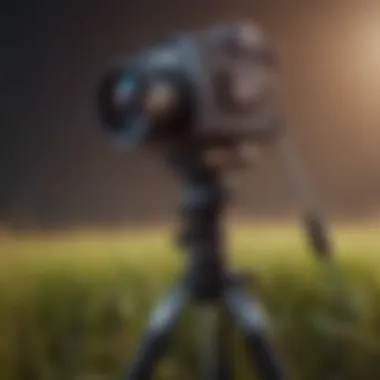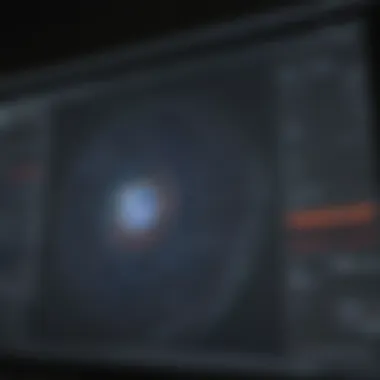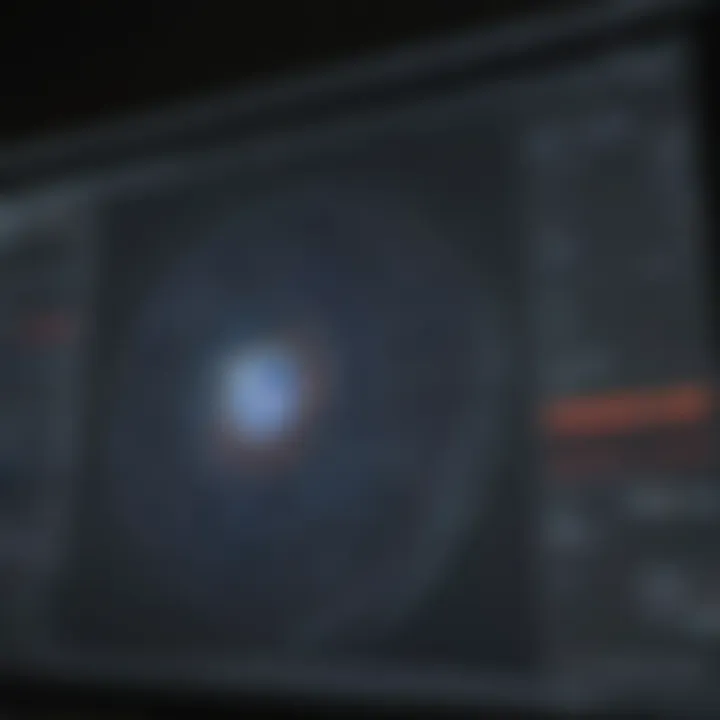Innovations in Portable Hyperspectral Camera Technology


Intro
The advent of portable hyperspectral cameras represents a significant evolution in remote sensing technology. Understanding their complexities and functionalities requires delving into their core applications and the innovations that propel their development. In recent years, these devices have gained traction in various sectors, such as agriculture, environmental monitoring, and healthcare. This exploration aims to shine a light on what portable hyperspectral cameras are capable of and evaluates their efficacy across different fields.
Research Overview
Key Findings
Through rigorous examination of current literature, several key findings emerge regarding portable hyperspectral cameras:
- Data Acquisition Efficiency: Portable hyperspectral cameras gather vast amounts of spectral data, providing insights that traditional imaging methods often miss. This capability enhances accuracy in analyzing materials and environments.
- Advancements in Sensor Technology: Recent technological strides have significantly improved the sensitivity and resolution of these cameras, enabling their use in increasingly diverse applications.
- Real-time Analysis Capabilities: The integration of advanced algorithms allows for immediate data interpretation, facilitating quicker decision-making processes in sectors like agriculture and security.
Study Methodology
This article synthesizes findings from peer-reviewed journals, conference papers, and case studies related to hyperspectral imaging. Surveys were distributed to professionals operating within various sectors to gather firsthand experiences. Using qualitative data analysis methods, insights were categorized to showcase the innovations and challenges faced in real-world applications.
Background and Context
Historical Background
Hyperspectral imaging technology has origins in aerospace and defense applications, primarily for earth observation and reconnaissance. Over the past two decades, miniaturization and cost reduction have made portable versions available for various non-military markets. This transition expands their use to agricultural assessments, environmental monitoring, and public health initiatives.
Current Trends in the Field
Current trends highlight a growing integration of artificial intelligence with hyperspectral cameras, enhancing their capabilities. For instance, machine learning algorithms are increasingly used to analyze the large datasets generated, allowing for more sophisticated predictions and assessments based on spectral signatures. Additionally, a rise in consumer interest in sustainability has led to increased adoption of these cameras in ecological research and environmental management.
"The potential applications are vast, and ongoing innovations in this technology will likely yield even more sophisticated tools for data collection and analysis."
The exploration into portable hyperspectral cameras is just commencing, and further research will continue to uncover their societal implications and enhancements.
Preamble to Portable Hyperspectral Cameras
Portable hyperspectral cameras represent a significant advancement in imaging technology. These devices serve a multitude of purposes across various fields due to their ability to capture detailed spectral information across a range of wavelengths. This introduction explores the fundamental aspects of portable hyperspectral cameras, spotlighting their importance in scientific research, industry, and environmental monitoring.
The core benefit of a portable hyperspectral camera is its capacity to gather vast amounts of data in real-time. Unlike conventional imaging systems that capture only a few spectral bands, hyperspectral cameras capture many, often exceeding hundreds. This capability allows for precise identification of materials, biochemical properties, and various environmental attributes. For instance, in agriculture, farmers can assess crop health more accurately, identifying plant stress before it becomes visible to the naked eye.
Practical considerations also arise, particularly regarding their portability. The design is evolving to become lighter and more compact, enhancing usability in the field. Professionals can easily transport these cameras to remote locations, allowing for versatile applications in different conditions. This flexibility is crucial for industries that demand quick and reliable data acquisition in varying environments.
Moreover, the integration of advanced data processing techniques has improved the interpretation of spectral data captured by these devices. Users can access insights that were once complicated to extract, thus making the technology more accessible to those who may not have extensive training in hyperspectral analysis.
Key Points of Discussion
- Technological Advancements - Developments in sensor technology and data analytics enhance the efficacy of these devices.
- Field Applications - Various sectors utilize portable hyperspectral cameras, expanding their relevance across industries such as agriculture, environmental science, and healthcare.
- Challenges and Limitations - While the usefulness is clear, factors such as data overload can complicate the analysis process. Cost considerations also play a role in their widespread adoption.
"The deployment of portable hyperspectral cameras can revolutionize data collection methods, reinforcing the intersection of technology and environmental science."
The significance of portable hyperspectral cameras cannot be overstated. As they gain traction, understanding their applications and evolving technology becomes essential for researchers, educators, and professionals. This article aims to provide that insight, paving the way for a deeper exploration of hyperspectral imaging's landscape and its potential to inform both commercial practices and scientific inquiry.
Fundamental Principles of Hyperspectral Imaging
The field of hyperspectral imaging is a critical component within the realm of remote sensing and imaging technology. Understanding its fundamental principles is paramount to appreciating the myriad applications and innovations associated with portable hyperspectral cameras. These cameras offer detailed spectral information that traditional imaging techniques simply cannot match. This section will address key elements like data acquisition methods, data processing, and what it fundamentally means to utilize hyperspectral imaging in various industries.
What is Hyperspectral Imaging?
Hyperspectral imaging captures a wide spectrum of light for each pixel in the image. Unlike traditional color imaging that typically uses three channels (red, green, and blue), hyperspectral imaging collects data across many more spectral bands, often hundreds. This allows for a much richer set of data. Hyperspectral images are effectively three-dimensional data cubes, where two dimensions represent spatial information and the third dimension represents the spectral information.
The uniqueness of hyperspectral imaging lies in its ability to identify materials, detect processes, and determine conditions based on their spectral signatures. Each material has a unique spectral response. By analyzing these signatures, researchers and professionals can make informed decisions in applications such as agriculture, environmental monitoring, and industrial quality control.
Spectral Data Acquisition
The process of spectral data acquisition is vital for obtaining quality, actionable information from a hyperspectral imaging system. Typically, this involves a two-step process: illumination and detection. Illumination sources, such as sunlight or controlled light, help effectively capture the spectral data of the target object. After illumination, a sensor array captures the spectral information according to specific wavelengths.
The quality of data acquisition directly influences the subsequent analysis. Factors such as signal-to-noise ratio, spectral resolution, and the range of wavelengths captured are crucial to consider. Higher resolution allows for more detailed identification of materials. For instance, in agriculture, precise data can highlight crop stress early on, enabling proactive measures for enhanced yield.
Data Processing Techniques
Data processing is where the real work begins following the acquisition of spectral data. The volume of data generated by portable hyperspectral cameras can be immense, often leading to what is known as data overload. Therefore, it is essential to implement effective data processing techniques to extract meaningful insights from this vast quantity of information.
Processing techniques can vary from basic reflectance correction to advanced machine learning algorithms. Common initial steps include noise reduction and calibration adjustments. Subsequently, more sophisticated methods, such as dimensionality reduction, can enhance the analysis.
Techniques like Principal Component Analysis (PCA) help in reducing the complexity of hyperspectral data while retaining significant variability. This simplification not only aids in visual interpretation but also facilitates machine learning applications for broader decision-making automation. Such methodologies are increasingly important as industries strive to derive actionable insights from hyperspectral imaging data.
The intricacy of data processing in hyperspectral imaging dictates the success of its applicability in diverse fields.
By examining these principles in detail, we lay the foundation for exploring specific applications across agriculture, environmental monitoring, and numerous industrial domains. Understanding these fundamental components empowers researchers and professionals to use portable hyperspectral cameras effectively.
Technical Specifications of Portable Hyperspectral Cameras
Understanding the technical specifications of portable hyperspectral cameras is essential for comprehending their capabilities and limitations. These specifications directly impact their performance across various applications. For researchers and professionals working with these devices, knowing the right specifications helps in making informed decisions about their suitability for specific tasks.
Sensor Technology
Sensor technology is a crucial aspect of hyperspectral cameras. The sensors are responsible for capturing data across various wavelengths. Modern portable hyperspectral cameras utilize different types of sensors, including Charge-Coupled Devices (CCDs) and Complementary Metal-Oxide-Semiconductors (CMOS). Each type comes with its advantages.
For instance, CCDs typically offer higher sensitivity and lower noise under low-light conditions, making them ideal for applications like remote sensing. In contrast, CMOS sensors provide faster readout speeds, which are beneficial for dynamic scenarios, such as monitoring moving objects. The choice of sensor technology can notably influence image quality and accuracy in detected information.
Spectral Range and Resolution
The spectral range and resolution play significant roles in the effectiveness of hyperspectral imaging. Spectral range refers to the wavelengths that a camera can capture, often defined within the visible spectrum to infrared. Generally, a broader spectral range allows for a more detailed analysis of materials and substances.
Resolution entails how finely the camera can differentiate between different wavelengths. High resolution is essential for applications requiring precise material identification. For example, in agriculture, understanding subtle differences in plant health can be achieved more effectively with devices that offer high spectral resolution. Balancing these aspects is key in selecting the right hyperspectral camera.
Size, Weight, and Portability


Portability is one of the defining features of modern hyperspectral cameras. The design focuses on reducing size and weight without sacrificing performance. Portable cameras can be easily deployed in varying environments, which enhances their usability in fields such as environmental monitoring or agricultural assessments.
Moreover, the ease of mobility allows researchers to conduct studies in remote areas where traditional large imaging systems would be impractical. This characteristic contributes to the growing adoption of hyperspectral technology in both academic and industry-related fields.
"The ability to conduct hyperspectral imaging in diverse environments is crucial for many scientific and industrial applications."
In summary, the technical specifications of portable hyperspectral cameras determine how effectively they can perform in various applications. Understanding sensor technology, spectral range and resolution, as well as considerations for size and weight, can lead to better decision-making in selecting the right equipment for specific needs.
Applications in Agriculture
The integration of portable hyperspectral cameras within agricultural practices presents a transformative potential for efficiency and productivity. As the demand for food increases globally, farmers and agricultural scientists seek innovative ways to monitor crop health and enhance productivity. Portable hyperspectral imaging stands at the forefront of these advancements, allowing for detailed analysis that traditional methods cannot achieve. This section will explore the applications of these cameras, specifically focusing on crop health monitoring and soil composition analysis.
Crop Health Monitoring
Crop health monitoring is a critical aspect of modern agriculture, as it allows farmers to assess the vitality and growth of their crops effectively. Through the use of portable hyperspectral cameras, farmers can analyze the reflectance of light from different plants, identifying stress factors such as nutrient deficiency, disease, and water stress at an early stage. The key benefits include:
- Early Detection: Hyperspectral imaging can identify crop stress before it is visible to the naked eye, enabling timely interventions.
- Precision Agriculture: By analyzing specific wavelengths of light, farmers can apply fertilizers and pesticides in a targeted manner, reducing waste and minimizing environmental impact.
- Yield Prediction: With historical data and regular monitoring, these cameras can facilitate accurate predictions of crop yield, assisting in planning and resource allocation.
An important aspect is the ability to process large amount of data. Advanced algorithms and machine learning techniques can be employed to analyze the hyperspectral data, providing actionable insights for farmers. Moreover, the use of portable imaging equipment allows for field-based assessments rather than relying solely on laboratory tests. This real-time data collection is invaluable for immediate decision-making.
Soil Composition Analysis
Soil composition is fundamental to crop production as it directly influences plant growth and health. A portable hyperspectral camera can assess soil properties, including moisture content, organic matter, and mineral composition. Understanding soil composition allows farmers to optimize their agricultural practices. The advantages of using hyperspectral technology for soil analysis include:
- Rapid Assessment: Unlike traditional methods, hyperspectral imaging allows for quick and accurate evaluations of soil attributes.
- Spatial Variability Understanding: It aids in identifying spatial variations within fields. This insight helps in customized treatments for different soil zones rather than a one-size-fits-all approach.
- Sustainability: Farmers can make more informed decisions about crop rotations and cover cropping, fostering long-term soil health and sustainability.
Additionally, integrating this technology in soil management can contribute significantly to improving agricultural sustainability. As farmers gain insights into the specific needs of their soil, they can reduce inputs, enhance nutrient management, and ultimately protect the environment. In summary, the applications of portable hyperspectral cameras in agriculture, particularly regarding crop health monitoring and soil composition analysis, provide crucial advancements that hold promise for tackling current challenges in food production.
"The innovative capabilities of portable hyperspectral cameras can greatly enhance agricultural productivity and sustainability, offering farmers the tools they need to adapt to changing environmental conditions."
Environmental Monitoring and Conservation
The need for effective environmental monitoring and conservation strategies is more pressing than ever. Portable hyperspectral cameras have emerged as powerful tools in this context. They offer a means to assess environmental conditions and changes in a precise manner. By utilizing these devices, researchers and professionals can collect spectral information that reflects the details of habitats, ecosystems, and the overall health of the environment.
Water Quality Assessment
Water bodies are sensitive indicators of environmental health. Portable hyperspectral cameras provide a unique capability for water quality assessment. By analyzing the spectral signatures of water, these cameras can identify pollutants, assess turbidity, and detect harmful algal blooms. Traditional methods often require time-consuming laboratory tests, while hyperspectral imaging enables faster, more efficient analyses in the field.
Key benefits of this technology in water quality monitoring include:
- Real-time data collection: Immediate access to spectral data allows for prompt decision-making.
- Detailed analysis: High-resolution spectral data reveal subtle changes in water quality that may go unnoticed with conventional techniques.
- Broader coverage: The portability factor enables surveys over large areas, making it feasible to monitor remote or hard-to-reach locations.
These advantages significantly enhance the ability to protect aquatic ecosystems and manage water resources effectively.
"Portable hyperspectral cameras transform the way we approach environmental monitoring by providing depth and precision that was previously unattainable."
Biodiversity Studies
Biodiversity is crucial for ecosystem stability and resilience. Portable hyperspectral cameras have distinct applications in studying and conserving biodiversity. These devices can help in identifying species composition and distribution in various habitats. By analyzing the spectral data, researchers can differentiate between plant species, assess habitat changes, and monitor the effects of climate change on ecosystems.
The role of hyperspectral imaging in biodiversity studies includes:
- Species identification: Spectral libraries can be created to match spectral signatures with known species, facilitating accurate identification.
- Habitat mapping: Researchers can map different vegetation types, understand their distributions, and detect shifts over time.
- Ecosystem health monitoring: Regular assessments using hyperspectral data can track the health of ecosystems, indicating potential decline or degradation.
Industrial Applications
Portable hyperspectral cameras have profound importance across various industrial sectors. Their capacity to analyze materials with high precision opens new avenues for innovation and efficiency. Being able to quickly identify material compositions aids in optimizing processes, reducing waste, and ensuring product quality. These cameras provide detailed spectral information, making them essential tools for industries such as mining, manufacturing, and recycling.
Material Identification and Sorting
Hyperspectral imaging technology allows for the differentiation of materials based on their spectral signatures. This identification process is crucial in waste management and recycling, where sorting materials accurately can greatly impact resource recovery. With portable hyperspectral cameras, operators can quickly scan large piles of materials, often in real-time, thereby minimizing manual sorting efforts.
Some specific benefits include:
- Increased accuracy: Traditional sorting methods often rely on visual inspection or basic sensors. Hyperspectral cameras provide detailed data that helps distinguish between similar materials, leading to enhanced precision.
- Time efficiency: Speed is a critical factor in industrial processes. Hyperspectral imaging significantly reduces the time required for material analysis, allowing for rapid decision-making.
- Cost savings: By optimizing material use and reducing contamination in recycled products, companies can save on operational costs and improve overall profitability.
Quality Control in Manufacturing
In the context of manufacturing, ensuring product quality is paramount. Portable hyperspectral cameras play a vital role in quality control measures. They facilitate the monitoring of product attributes, such as color consistency, composition verification, and contamination detection, throughout the production cycle.
Key aspects of using hyperspectral imaging for quality control include:
- Non-destructive testing: Unlike traditional methods that may require sample destruction, hyperspectral imaging allows for testing without impacting the material's integrity. This feature is particularly valuable in industries like food and pharmaceuticals.
- Real-time monitoring: The ability to analyze products continuously means that deviations from quality standards can be detected immediately. This immediate feedback helps maintain high-quality output and reduces defects.
- Comprehensive data analysis: Each scan generates extensive data that can be used to identify trends and patterns over time. This information aids in optimizing manufacturing processes and improving overall product quality.
"The implementation of portable hyperspectral cameras in manufacturing not only enhances quality assurance but also drives innovation in product development."
As industries continue to adapt to technological advancements, integrating portable hyperspectral cameras into processes will likely become a standard. The ongoing research and developments in this area can significantly contribute to creating smarter and more efficient industrial operations.
Medical Diagnostics and Healthcare
Medical diagnostics and healthcare represent one of the most significant applications of portable hyperspectral cameras. By enabling detailed analysis of biological tissues and pharmaceuticals, these cameras can enhance diagnostic precision and contribute to advancements in patient care. The ability to capture and analyze spectral data non-invasively also signifies a shift toward more patient-friendly diagnostic procedures. This section explores several key areas where hyperspectral imaging is making a substantial impact.
Tissue Analysis
Hyperspectral imaging offers a powerful tool for tissue analysis in medical diagnostics. This technology allows for real-time imaging of tissue spectral signatures, enabling healthcare professionals to distinguish between healthy and abnormal tissues with high accuracy. By analyzing the reflected light from tissue samples at various wavelengths, practitioners can identify specific biochemical properties that may indicate disease.
Key benefits of hyperspectral tissue analysis include:
- Enhanced Detection of Diseases: Early identification of conditions such as cancer through detailed mapping of tissue composition.
- Non-Invasive Procedures: Minimizing the need for biopsies or invasive techniques, leading to less discomfort for patients.
- Rapid Diagnostics: Offering timely insights that support immediate clinical decision-making.
Despite its advantages, there are challenges that must be addressed, such as the complexity of spectral data interpretation and the need for specialized training for health professionals.
Drug Analysis and Development


In the realm of drug analysis, portable hyperspectral cameras play a crucial role in the investigation of new pharmaceutical compounds. By analyzing the spectral characteristics of various substances, researchers can monitor chemical compositions, ensuring quality and efficacy in drug formulation. This capability is particularly important in the development of targeted therapies, where precise drug delivery mechanisms are critical.
Some specific contributions of hyperspectral imaging to drug analysis and development include:
- Quality Control: Ensuring that raw materials and finished products meet stringent pharmaceutical standards.
- Formulation Development: Assessing the interactions between different ingredients, optimizing formulations for better therapeutic outcomes.
- Counterfeit Detection: Identifying counterfeit drugs through spectral fingerprinting, enhancing patient safety.
Together, these areas highlight the transformative potential of portable hyperspectral cameras in medical diagnostics and healthcare.
"The integration of hyperspectral imaging can revolutionize patient diagnostics, representing the future of personalized medicine."
Mastering the technology and understanding its implications will be critical for professionals in healthcare. As innovations continue, the need for training and understanding of hyperspectral principles will shape the future landscape of medical diagnostics.
Challenges and Limitations
The integration of portable hyperspectral cameras into various fields presents both opportunities and challenges. While these devices offer unique insights through spectral imaging, they also come with specific limitations that must be addressed to realize their full potential. Understanding these challenges is critical for researchers and practitioners aiming to utilize this technology effectively.
Data Overload
One significant concern with portable hyperspectral cameras is data overload. These devices generate vast amounts of data due to their high spectral resolution. Each hyperspectral image may contain three-dimensional data cubes, with hundreds of spectral bands for each pixel. This can lead to complexities in storage, processing, and analysis.
The sheer volume of data can overwhelm standard processing techniques. Consequently, specialized algorithms and software are necessary for effective data management. Professionals using portable hyperspectral cameras must invest time in developing these tools to ensure efficient analysis. Furthermore, interpreting the data requires not just technical skills but also domain expertise in areas such as agriculture or environmental science, adding another layer of complexity.
"Data overload can hinder the timely decision-making that hyperspectral imaging aims to facilitate."
Cost Considerations
Cost considerations are another pivotal challenge for the adoption of portable hyperspectral cameras. While prices have decreased over the years, acquiring these devices still represents a considerable investment, especially for academic institutions or small businesses. The initial costs include purchasing the camera, necessary accessories, and establishing an appropriate processing infrastructure.
Furthermore, ongoing costs such as software licenses, maintenance, and training personnel should also be factored into the equation. Organizations must assess whether the benefits provided by the technology justify these expenses. It is essential to analyze not just the immediate financial impacts but also the long-term return on investment, considering the potential for enhanced data collection, efficiency, and innovation that portable hyperspectral cameras can provide.
Future Trends in Hyperspectral Imaging Technology
The field of hyperspectral imaging is at a crucial juncture, where new technologies and methodologies are beginning to reshape its future. Portable hyperspectral cameras have gained traction because they deliver high-quality imaging solutions in various applications. Looking ahead, a few significant trends are emerging in this sphere, particularly related to advancements in sensor design and the integration of artificial intelligence. Understanding these trends is vital, as they shape the effectiveness and potential utilization of hyperspectral imaging in diverse fields.
Advancements in Sensor Design
As the demand for portable hyperspectral cameras grows, the innovation in sensor technology is becoming critical. Modern sensors are becoming increasingly sophisticated, addressing issues related to size, weight, and performance. Key advancements include:
- Miniaturization: Manufacturers are creating smaller sensors that do not compromise on features. This allows for greater portability and ease of use, making hyperspectral imaging accessible in hard-to-reach locations.
- Enhanced Spectral Coverage: New sensors are expanding their spectral ranges, allowing for more extensive data collection across various wavelengths. This capability enhances analysis across different applications, from agriculture to medical imaging.
- Improved Sensitivity: Recent designs are focusing on increasing the sensitivity of sensors. Better sensitivity leads to clearer images and more accurate analyses, which is vital for precise evaluations in different scenarios.
These sensor advancements are setting the stage for the next generation of portable hyperspectral cameras, pushing boundaries in data collection and quality.
Integration with Artificial Intelligence
The incorporation of artificial intelligence (AI) in hyperspectral imaging is another trend set to revolutionize this field. AI technologies are enabling portable hyperspectral cameras to process and analyze data in real-time. Several aspects of this integration are noteworthy:
- Automated Data Analysis: AI algorithms can analyze hyperspectral data much faster than human experts. They can identify patterns, classify materials, and extract information without human intervention, making the process far more efficient.
- Enhanced Image Processing: Machine learning techniques improve the quality of the images captured. AI can reduce noise, enhance contrast, and optimize the visual representation of spectral data, leading to better results in applications.
- Predictive Modeling: AI can also predict outcomes based on historical data. In agriculture, for instance, the ability to forecast crop health based on hyperspectral data can lead to proactive interventions.
The fusion of AI with hyperspectral imaging is not just a trend; it's an evolution that enhances the functionality and applicability of these imaging technologies. By allowing for quicker insights and more accurate analyses, AI integration is turning portable hyperspectral cameras from mere data collectors into decision-making tools.
"The future of portable hyperspectral imaging is not solely about capturing data but transforming that data into actionable insights through advanced technologies."
In summary, the future trends in hyperspectral imaging technology spotlight significant innovations in sensor design, leading to increased portability and enhanced imaging capabilities, while the incorporation of artificial intelligence is setting a new standard for data processing and analysis. As these trends continue to evolve, they will undoubtedly expand the applications and benefits of portable hyperspectral cameras across various fields.
Case Studies of Portable Hyperspectral Cameras
The segment on case studies serves a crucial role in contextualizing the applications and innovations of portable hyperspectral cameras. Case studies provide real-world examples that illustrate the effectiveness of these devices across various fields. By examining detailed instances of their use, readers can grasp not only the technological capabilities but also understand practical implications and results. This section connects theory with practice, allowing for a deeper understanding of how portable hyperspectral cameras contribute to advancements in industries such as agriculture and environmental science.
Field Research in Agriculture
Field research utilizing portable hyperspectral cameras has made significant strides in agriculture. These devices enable farmers and researchers to gather spectral data efficiently. One prominent application is in assessing crop health. By collecting data on leaf reflectance, experts can determine the physiological conditions of plants. This information helps identify areas affected by diseases or water stress early on. It allows for timely interventions, reducing crop loss and improving yields.
Benefits of using hyperspectral imaging in agriculture include:
- Precision Agriculture: Farmers can apply fertilizers and pesticides more precisely, enhancing efficiency and minimizing environmental impact.
- Soil and Crop Monitoring: Regular monitoring with these devices provides data over time, allowing for better planning and resource allocation.
- Integration with Other Technologies: Combining hyperspectral cameras with drones or satellites can provide extensive insights and facilitate large-scale monitoring.
However, challenges do remain. The cost of technology and need for specialized training can be barriers to adoption. Farmers must also learn how to interpret the data effectively to make informed decisions.
Remote Sensing Applications in Environmental Science
Remote sensing is another area where portable hyperspectral cameras have made a considerable impact. These cameras are employed to monitor environmental changes, providing valuable data for climate studies and natural resource management. In particular, they help in assessing water quality, tracking deforestation, and mapping vegetation changes.
Some notable applications include:
- Water Quality Monitoring: Hyperspectral cameras can detect pollutants in water bodies by analyzing spectral signatures. This technology allows for rapid assessments without the need for extensive field sampling.
- Biodiversity Tracking: Researchers utilize these cameras to monitor ecosystems and analyze changes in plant species distribution and health. This is especially important in the context of climate change and habitat loss.
- Land Use Change Detection: By examining satellite images over time, researchers can assess changes in land use due to agriculture, urban expansion, or natural events.
Overall, the integration of portable hyperspectral cameras into remote sensing enhances data collection processes, providing researchers with unprecedented insights into environmental dynamics.
"The detailed spectral data collected can transform our understanding of environmental processes and enable more informed decision-making in conservation efforts."
Through these case studies, it becomes apparent that the use of portable hyperspectral cameras extends beyond simple imaging to transformative applications that benefit both scientific research and practical outcomes in agriculture and environmental science.
Regulatory and Ethical Considerations
The integration of portable hyperspectral cameras into various fields generates substantial interest, not only for their technological innovations but also for the regulatory and ethical implications they introduce. Their capacity to collect vast amounts of spectral data brings about a necessity to examine privacy, environmental, and ethical frameworks governing their use. Each aspect plays a crucial role in ensuring that the technology benefits society while minimizing risks.
Data Privacy Issues
As hyperspectral imaging becomes more prevalent, concerns about data privacy emerge. With the ability to capture detailed information about objects and environments, these cameras can inadvertently collect sensitive data. For instance, when used in public areas or during personal interactions, they may record information that could lead to the identification of individuals. This raises important questions regarding consent and the protection of personal data. Currently, many regions have laws protecting individual privacy in technology usage, such as the General Data Protection Regulation (GDPR) in the European Union.
It is essential for organizations using portable hyperspectral cameras to institute clear guidelines and policies on data collection and usage. Ensuring the anonymity of data and acquiring consent before collecting images, particularly in sensitive situations, are crucial steps. Regular audits and transparent processes can enhance trust among users and stakeholders.
Compliance with Environmental Regulations


The deployment of portable hyperspectral cameras frequently intersects with environmental regulations. These cameras are widely used in monitoring ecosystems, assessing pollution levels, and studying biodiversity. Hence, compliance with environmental laws is vital. Relevant regulations aim to protect natural resources, minimize ecological impact, and ensure sustainable practices.
In many countries, users must obtain permits before conducting studies that may affect the environment. Additionally, they must adhere to guidelines for collecting data in sensitive habitats. This responsibility ensures that research activities do not disrupt ecosystems or harm wildlife. Moreover, proper training on compliance with local and international standards can help users of these cameras navigate legal frameworks effectively.
"Understanding and adhering to regulatory and ethical considerations in the use of portable hyperspectral cameras is crucial for advancements in technology without sacrificing public trust and environmental integrity."
Comparison with Traditional Imaging Techniques
When evaluating the effectiveness of portable hyperspectral cameras, it is vital to compare them with traditional imaging techniques. The distinctions become evident in areas such as data richness, spectral resolution, and usability in diverse applications. Traditional imaging methods often capture limited spectral information, which can restrict their diagnostic capabilities. As hyperspectral imaging systems capture a wider range of wavelengths, including those not visible to the human eye, they offer clearer insights into the materials being studied. This approach can yield more accurate results in various fields including agriculture, environmental monitoring, and industrial applications.
Strengths of Hyperspectral Imaging
Hyperspectral imaging presents several strengths that set it apart from traditional methods.
- Comprehensive Data Capture: Hyperspectral cameras collect a vast amount of spectral data over hundreds of bands, providing detailed material characterization. This allows for precise identification of substances based on their spectral fingerprints.
- Enhanced Material Identification: The data acquired can help in distinguishing between materials that might appear similar in color or structure. This is beneficial in industries like pharmaceuticals, where identifying active chemical compounds is crucial.
- Non-Destructive Analysis: Hyperspectral imaging allows for analysis without altering or destroying samples. This is particularly important in applications like art preservation or biological studies.
- Real-Time Monitoring: Portable devices enable field-based real-time monitoring of crop health, environmental conditions, or product quality, giving users the ability to react quickly to findings.
These strengths significantly contribute to the growing interest in the adoption of hyperspectral imaging technologies across various sectors.
Limitations Compared to Multispectral Imaging
While hyperspectral imaging is powerful, it is important to also recognize some limitations when compared to multispectral imaging.
- Higher Cost and Complexity: The advanced technology behind hyperspectral cameras usually results in higher costs. This financial barrier may restrict their accessibility in some applications where simpler multispectral imaging could suffice.
- Data Processing Requirements: The volume of data generated is substantial, necessitating sophisticated processing techniques and advanced software. Thus, users may need more training and expertise to handle hyperspectral data effectively.
- Potential Overhead: In situations where only a few specific wavelengths are necessary for analysis, multispectral imaging could provide a more efficient solution, as it focuses on designated bands to keep data handling manageable.
By understanding the strengths and limitations of hyperspectral imaging in comparison to traditional techniques, researchers and industry professionals can better assess its application in their specific fields. This knowledge is essential in making informed decisions about technological investments and methodology choices.
Market Trends and Industry Insights
Understanding the market trends and overall industry insights regarding portable hyperspectral cameras is essential for professionals, educators, and researchers in the field. As technologies evolve rapidly, grasping these changes enables stakeholders to gauge the progress and direction of hyperspectral imaging.
Market trends reveal how demand shifts with technological advancements and societal needs. Portable hyperspectral cameras serve various sectors including agriculture, healthcare, and environmental monitoring. By analyzing these trends, it becomes clear how businesses can leverage these innovations for more efficient data collection and analysis.
Current Market Landscape
The current landscape for portable hyperspectral cameras is characterized by steady growth and increasing adoption. Today's devices are more affordable and user-friendly compared to earlier models. This accessibility opens doors for various applications, even among smaller enterprises and research institutions.
Key factors shaping the market include:
- Technological advancements: New sensor designs and software solutions are enhancing capabilities.
- Educational investments: Universities and research institutions are increasingly funding related projects.
- Collaborations across sectors: Partnerships between tech companies and industries enhance innovation.
Despite these positives, competition remains fierce. Companies are focusing heavily on differentiation through features and applications.
Emerging Markets for Portable Hyperspectral Cameras
Several emerging markets are tuning into the other-dimensional benefits of hyperspectral imaging. Industries are beginning to uncover potential applications that were previously unexplored. Some notable areas include:
- Smart Farming: Integrating hyperspectral cameras with precision agriculture to optimize crop yields.
- Pharmaceuticals: Enhancement in drug formulation and testing processes using imaging technologies.
- Environmental Monitoring: Continuous evaluation of ecosystems, facilitating faster responses to environmental changes.
Investment in research and development is crucial for tapping into these emerging markets. Identifying opportunities in sectors like renewable energy and urban planning can create new avenues for growth. As more industries recognize the advantages of portable hyperspectral cameras, their implementation is likely to expand.
Educational and Research Funding Opportunities
Educational and research funding opportunities play a crucial role in advancing the field of portable hyperspectral cameras. These funding avenues facilitate the development of new technologies, promote innovative applications, and enhance the overall knowledge base surrounding hyperspectral imaging. Researchers and educators can leverage these opportunities to acquire the necessary resources, support, and infrastructure to explore significant questions in the field.
The significance of funding in education and research extends beyond financial support. It also encourages collaboration among institutions and industry, fostering an environment where advancements can flourish. Such collaboration can lead to the establishment of interdisciplinary teams, encouraging diverse perspectives that can enhance research outcomes and applicability. Additionally, grants and funding packages often come with specific objectives, compelling researchers to align their work with current needs and technological trends.
Grants for Hyperspectral Research
Grants specifically designated for hyperspectral research provide a pathway for scientists and academics to pursue projects that may otherwise be beyond their financial reach. These grants can fund equipment, research assistants, and project-related expenses such as travel and dissemination of results. Various organizations, such as the National Science Foundation (NSF) and private foundations, offer grants targeting emerging technologies in imaging science and agriculture.
The application process for these grants usually involves compiling detailed proposals. Researchers must clearly outline the objectives, methodology, and expected outcomes of their projects. This process encourages thorough planning and thoughtful consideration of how the research contributes to the field. The resulting projects can lead to groundbreaking insights, charting new territories in hyperspectral imaging applications.
Here are some notable sources for grants in hyperspectral research:
- National Institutes of Health (NIH)
- U.S. Department of Agriculture (USDA)
- Economic and Social Research Council (ESRC)
Collaborative Projects in Hyperspectral Imaging
Collaborative projects in hyperspectral imaging are vital as they combine expertise from various domains. Such partnerships can take many forms, from joint research initiatives involving universities and industry stakeholders to interdisciplinary studies that involve combined perspectives from environmental science, agriculture, and engineering.
Collaborations open doors for significant resource sharing. They allow individual researchers to access a broader array of equipment and expertise while distributing the workload among team members. Additionally, these projects often yield comprehensive datasets that are invaluable for future studies and applications.
One prominent example of collaborative efforts can be seen in the partnership between academic institutions and private sector companies. These collaborations have led to the development of advanced imaging technologies, ensuring that research aligns closely with industry demands. Educational institutions can also gain access to real-world applications of their research, enhancing the learning experience for students.
Epilogue and Summary
The exploration of portable hyperspectral cameras highlights their significant role in advancing scientific research and industrial applications. This technology not only facilitates enhanced data collection but also opens new avenues for analysis. The insights gained through hyperspectral imaging contribute to better decision-making across various fields such as agriculture, environmental monitoring, and healthcare.
Key elements of this discussion include:
- Implications of Hyperspectral Technology: Understanding the transformative effects of this technology on data acquisition.
- Future Directions in Research: Identifying areas where further studies could enhance the capabilities and applications of hyperspectral cameras.
The benefits of these innovations are manifold. Portable hyperspectral cameras allow users to obtain detailed spectral information about materials, enabling precise monitoring and analysis. This capability fosters improved practices in sectors such as agricultural health assessments, where timely interventions can lead to increased productivity.
Furthermore, as this technology evolves, considerations about cost and accessibility must be addressed. Ensuring that portable hyperspectral cameras are affordable and easy to use will expand their adoption. This, in turn, can stimulate research and development, leading to new insights and applications.
In summary, the implications and potential of portable hyperspectral cameras extend far beyond their current use. They are poised to significantly influence various domains as researchers and professionals continue to discover innovative applications.
Implications of Hyperspectral Technology
The implications of hyperspectral technology are profound. This technology enables the non-destructive analysis of materials, offering a wealth of information previously unavailable through traditional imaging techniques. Its ability to collect vast amounts of spectral data allows for detailed characterization of substances, which can lead to breakthroughs in areas such as agricultural sciences, where monitoring plant health is crucial.
With the increase in data collection capabilities, there is also an enhancement in data analysis techniques. Advanced algorithms are being developed to interpret hyperspectral data efficiently, which can streamline processes in sectors like manufacturing and medical diagnostics. Consequently, the refinement of analysis methods is essential to leverage the full potential of hyperspectral imaging.
Future Directions in Research
Looking ahead, several future directions in research are worth noting. One prominent area is the integration of artificial intelligence with hyperspectral imaging. This convergence can create powerful tools for data analysis, making it simpler to relate complex hyperspectral data to actionable insights.
Moreover, researchers should focus on improving sensor technologies to enhance spectral resolution and sensitivity. This can broaden the range of applications and make these cameras more useful in challenging environments.
Collaboration between academia and industry can foster innovation, leading to new applications that directly address global challenges such as climate change and food security.







